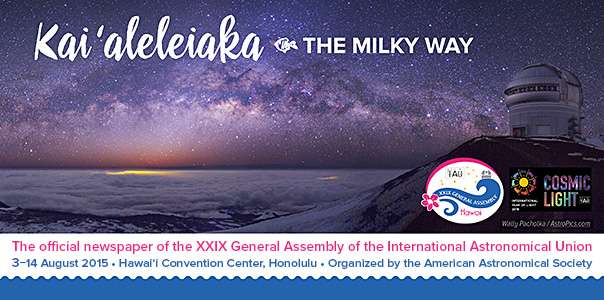
For more than a half century, beginning with the X General Assembly in Moscow in 1958, each triennial gathering of the IAU has featured a daily newspaper produced by astronomers and science writers appointed by the host organization. With previews by plenary speakers and session chairs, program updates and travel tips from local organizers, and news reports from each day’s meetings and other activities, the GA newspaper is an important source of must-have information for attendees.
Traditionally the GA newspaper has been prepared each day, printed overnight, and distributed each morning. In Honolulu we are breaking with this tradition and starting a new one: The newspaper is being produced and distributed 100% digitally for viewing on attendees’ laptops, tablets, and smartphones — though it is formatted for printing on U.S. standard 8½-by-11-inch paper for the convenience of those who prefer having their newspaper on actual paper.
Newspaper files are PDFs suitable for viewing in Adobe Reader or any other PDF-compatible application. We chose PDF as our file format because PDFs can be read on machines of all types running Mac OS, Windows, Android, Unix, and a variety of other operating systems. Each daily edition will be available for downloading early each morning or perhaps late the preceding evening.
Note that even if we had wanted to print the newspaper in the traditional way, we would not have been able to do so, as no commercial printer on the island of Oahu has enough press capacity to print another daily paper in addition to their regularly scheduled publications.
The XXIX GA newspaper is called Kai‘aleleiaka (“kah EE ah lay-lay-ee AH kah”), which means “the Milky Way” in Hawaiian. As seen from Hawai‘i in August, the galactic center stands high in the south during prime evening skygazing hours, and later at night you can trace the Milky Way from the southern horizon, through the zenith, to the northern horizon — though not necessarily from brightly lit Honolulu! There are other ways to say “the Milky Way” in Hawaiian, but Kai‘aleleiaka is especially well suited for our astronomical purpose, since it is the term used by Polynesian voyagers who navigated the Pacific Ocean by the stars. The literal translation of Kai‘aleleiaka is “the fish jumping [or flopping] in shadows,” an apt description of the dark-cloud-studded band of starlight rising in the east, culminating high overhead, and descending in the west.
